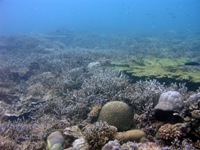Difference between revisions of "Why is Marine biodiversity important"
| Line 27: | Line 27: | ||
== References == | == References == | ||
<references/> | <references/> | ||
| + | |||
| + | ==See Also== | ||
| + | [[Category:Coastal and marine issues and impacts]] | ||
Revision as of 15:51, 8 January 2009
Looking at ecosystems in terms of the goods and services they provide allows us to realise their full value and our dependence on those systems in the broadest sense. Exploitation of the environment for one purpose can alter the environment's ability to provide other goods and services, so this knowledge is also a way of understanding what we stand to gain and lose by exploitation of certain aspects of the environment [3]. The main goods and services provided by marine ecosystems are:
- Resilience and resistance
- Disturbance prevention
- Nutrient cycling
- Greenhouse gas and climate regulation
- Bioremediation of waste
- Biologically mediated habitat
- Food provision
- Raw materials, including ornamental resources
- Leisure
- Cultural values
- Information service
- Non-use value: bequest value and existence value
- Option use value
Other types of biodiversity
Biodiversity encompasses many levels of organisation including genes, species, habitats, communities and ecosystems. Although species diversity is the most commonly used measure of taxonomic diversity (or diversity between types of organisms), other measures of taxonomic diversity exist, the most common of which is phyletic diversity. Phyletic diversity is the variation in the working body plans (phyla) of organisms. An example of a phylum is the Arthropoda, which includes the class Decapoda. Phyletic diversity can be a useful measure of diversity, particularly where diversity is comparably higher at the level of phylum than at the level of species. For example, the marine environment has high phyletic diversity because 32 out of the 33 described animal phyla are represented in the oceans.
It is also possible and very useful to measure diversity as the variation in the functional roles of species (rather than the number of species or gene types), within a community or ecosystem. An example of functional diversity is the number of filter feeders in an ecosystem compared to number of grazers. Functional diversity is thought to be one of the main factors determining the long-term stability of an ecosystem and its ability to recover from major disturbances.
References
- ↑ Holmlund C. M. and Hammer, M (1999) Ecosystem services generated by fish populations Ecological Economics 29: 253-268
- ↑ Beaumont, N.J. and Tinch, R. (2003) Goods and services related to the marine benthic environment. CSERG working Paper ECM 03-14
- ↑ De Groot, R. S., Wilson, M. A. and Boumans, R. M. J. (2002) A typology for the classification, description and valuation of ecosystem functions, goods and systems Ecological Economics 41 (3): 393-408
